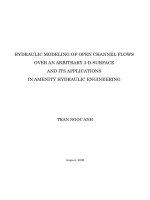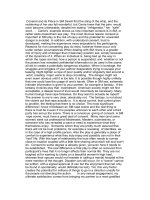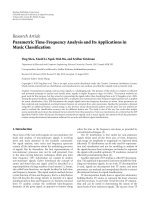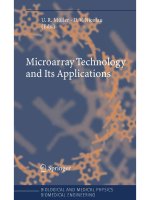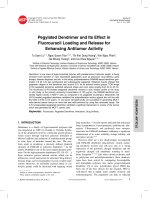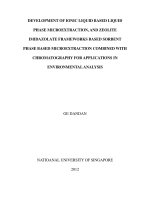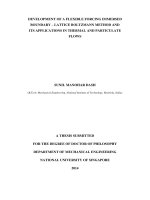Single base extension reaction and its applications in environmental microbiological studies
Bạn đang xem bản rút gọn của tài liệu. Xem và tải ngay bản đầy đủ của tài liệu tại đây (1.52 MB, 188 trang )
SINGLE BASE EXTENSION REACTIONS AND THEIR
APPLICATIONS IN ENVIRONMENTAL
MICROBIOLOGICAL STUDIES
HONG PEI YING
NATIONAL UNIVERSITY OF SINGAPORE
2009
SINGLE BASE EXTENSION REACTIONS AND THEIR
APPLICATIONS IN ENVIRONMENTAL
MICROBIOLOGICAL STUDIES
HONG PEI YING
(B. Eng (Hons), NUS)
A THESIS SUBMITTED
FOR THE DEGREE OF DOCTOR OF PHILOSOPHY
DIVISION OF ENVIRONMENTAL SCIENCE AND
ENGINEERING
NATIONAL UNIVERSITY OF SINGAPORE
2009
i
Acknowledgements
I am grateful for the presence of many special people throughout these five years. They
encourage, inspire and provide me with ample opportunities to discover my passion for
research. A big thank you to the following persons:
Professor Liu Wen-Tso, thank you for providing all the right formulations to groom me.
Professor F. Michael Saunders. He is the one who encouraged me to ask questions and is
always there to render ready assistance whenever needed.
Dr Wu Jer-Horng. He is a great mentor who tolerated with my ignorance when I first
started my candidature.
Dr Zhang Rui for his sincere advice.
Dr Zang Kaisai for the FISH images displayed at the last chapter of this dissertation.
The great seniors: Ezrein Shah Bin Selamat is my Yoda in microarray fabrication; Dr
Johnson Ng Kian Kok provides his excellent guidance in writing; Dr Pang Chee Meng
gives blunt criticisms and thought-provoking scientific discussions to improve myself; Dr
Chen Chia Lung shows me how patience is the key to eventual success.
The ESE administrative and lab staff. They shoulder the administrative headaches for me.
ii
All my lab friends and the cat. Thank you for your great company!
My family. My attitude towards research has made me a stranger to home. Thank you for
showering me with your never-ending understanding and concern.
For every ending lies a new beginning.
iii
Table of Contents
Acknowledgements… ………………………………….………………….…….…….…i
Table of Contents…………….…….……………… ……………… …….….……… iii
Summary……………………………………………………………………… …… ix
List of Tables………………………………………………………………… ….……. xii
List of Figures………………………………………………………………… ………xiv
Abbreviations………………………………………………………………….….… xvii
Publications……………………………………………………………………… … xix
Chapter 1: Introduction
1.1 Background and problem statement 1
1.2 Objectives and aims 5
1.3 Organization of thesis 11
Chapter 2: Literature Review
2.1 In the Land of the One-Eyed King, do we see the whole picture? 13
2.2 Limitations in the SSU rRNA-based approach 13
2.2.1 Sampling and storage bias 14
2.2.1.1 Sampling design 14
2.2.1.2 Sample storage 16
2.2.2 DNA extraction bias 17
2.2.3 PCR bias 19
2.2.3.1 False-negatives and false-positives 19
2.2.3.2 Microbial variability 21
iv
2.2.3.3 Oligonucleotide primers 22
2.2.4 Whole genome amplification (WGA) bias 24
2.3 Molecular tools 26
2.3.1 Identifying and profiling the change in microbial community 27
2.3.1.1 Microarray 27
2.3.1.2 16S rRNA gene libraries and metagenomics 30
2.3.1.3 Terminal restriction fragment length polymorphism 32
2.3.2 Quantifying the abundances of bacterial targets 33
2.3.2.1 Whole cell hybridization 33
2.3.2.2 Quantitative PCR (Q-PCR) 35
2.3.2.3 Hierarchical oligonucleotide primer extension (HOPE) 36
2.4 Environmental microbiological studies 40
2.4.1 Human gut and fecal microbiota 40
2.4.2 Water quality and human health 41
2.5 Concluding remarks 44
Chapter 3: Materials and Methods
3.1 Fecal samples 45
3.1.1 Human feces 45
3.1.2 Pig feces 46
3.1.3 Cow feces 46
3.1.4 Dog feces 46
3.2 Contaminated aqueous samples 47
3.2.1 Municipal wastewater 47
v
3.2.2 Swine wastewater 47
3.2.3 Aqueous medium contaminated with cow and dog feces 47
3.2.4 Blind samples 47
3.2.5 Environmental water samples 48
3.3 Bacterial reference strains 49
3.3.1 Bacteroides spp. 50
3.3.2 Bifidobacterium spp. 50
3.3.3 Animal-specific uncultivated Bacteroidales 51
3.3.4 Non-Bacteroides and Non-Bifidobacterium spp. 51
3.4 DNA extraction 52
3.5 Oligonucleotide primers 52
3.5.1 Oligonucleotide primers for PCR 52
3.5.2 Oligonucleotide primers for HOPE 53
3.5.3 Oligonucleotide primers for Q-PCR 57
3.5.4 Oligonucleotide probes for FISH-flow cytometry 59
3.6 Polymerase chain reaction 59
3.7 Hierarchical Oligonucleotide Primer Extension (HOPE) 60
3.7.1 Applied Biosystems PRISM 3130 60
3.7.2 Beckman Coulter CEQ 8000 61
3.7.3 Calculation of relative abundances of bacterial targets 62
3.8 Quantitative PCR (Q-PCR) 63
3.9 Fluorescent in-situ hybridization- flow cytometry (FISH-FC) 63
3.9.1 Cell fixation 63
vi
3.9.2 Cell permeabilization 64
3.9.3 Hybridization 64
3.9.4 Flow cytometry 64
3.10 Statistical and in silico analyses 65
3.10.1 Primer design 65
3.10.2 In silico analysis of probe specificity 65
3.10.3 Multi Dimensional Scaling 66
3.10.4 Correlation analysis 66
3.11 Nucleotide sequence ascension number 66
Chapter 4: Relative Abundance of Bacteroides spp. in Stools and Wastewaters as
Determined by Hierarchical Oligonucleotide Primer Extension (HOPE)
4.1 Abstract 67
4.2 Introduction 68
4.3 Results 74
4.3.1 PCR amplification 74
4.3.2 Specificity of primer extension 76
4.3.3 Calculation of calibration factor (CF) values 77
4.3.4 Electropherograms of tested samples 78
4.3.5 Relative abundance of Bacteroides spp. as determined by HOPE 80
4.3.6 Abundances of Bacteroides spp. as quantified by Q-PCR 86
4.3.7 Relative abundance of Bacteroides spp. in wastewaters 86
4.4 Discussion……………………………………………………………………. 89
vii
Chapter 5: A High-throughput and Quantitative Hierarchical Oligonucleotide
Primer Extension (HOPE)-based Approach to Identify Sources of Fecal
Contamination in Water Bodies
5.1 Abstract 94
5.2 Introduction 95
5.3 Results 99
5.3.1 Primer specificities 99
5.3.2 Detection limits of PCR assays and HOPE 102
5.3.3 HOPE-based approach on feces 102
5.3.4 HOPE-based approach on aqueous samples 106
5.3.5 HOPE-based approach on blind samples 107
5.3.6 HOPE-based approach on environmental waters 110
5.3.7 Validation by Q-PCR 111
5.3.8 Validation by fecal coliform test 113
5.4 Discussion 114
Chapter 6: Hierarchical Oligonucleotide Primer Extension (HOPE) as a Time- and
Cost-effective Approach for the Quantitative Determination of Bifidobacterium spp.
in Infant Feces
6.1 Abstract 118
6.2 Introduction 119
6.3 Results 120
6.3.1 Primer and probe specificities 120
6.3.2 Detection limits of newly designed HOPE primers 122
viii
6.3.3 Relative abundance of Bifidobacterium spp 123
6.3.4 Statistical correlation analysis 126
6.4 Discussion 127
Chapter 7: Conclusion and Recommendations
7.1 Conclusion 131
7.2 Recommendations 135
7.2.1 Method development 135
7.2.2 Environmental study 136
7.2.2.1 Human gut and fecal microbiota 136
7.2.2.2 Water quality and fecal source tracking 136
References………………………………………………………………………………138
ix
Summary
The study of microbial ecology involves identification and quantification of
functionally important microorganisms, which in turn are important steps necessary to
achieve homeostasis in both natural and engineered ecosystems. A small subunit (SSU)
rRNA-based approach can bring new insights to our understanding of the microbial
community, but is fraught with technical shortcomings at almost every step. A large suite
of molecular tools would allow one to complementarily utilize the most appropriate set of
experimental tools to address specific questions, therefore minimizing limitations and
biases associated with individual SSU rRNA-based method. Till today, quantitative-PCR
(Q-PCR) remains to be the most powerful tool to quantify abundances of bacterial targets
in environmental sample, but is limited in its throughput capabilities. This drives the need
to develop hierarchical oligonucleotide primer extension (HOPE) as an alternative method
that can complement Q-PCR and meet the needs for high-throughput quantitative
measurement of bacterial targets.
To achieve this overall objective, this dissertation first demonstrated in chapter 4
the applicability of HOPE to examine microbiota in feces and fecal-contaminated
environment. Nineteen oligonucleotide primers that target 14 functionally important
Bacteroides spp. are designed and applied in HOPE to detect and quantify their
abundances in feces and contaminated wastewaters. The findings show that the 14
Bacteroides spp. are human-associated and are present in human feces at abundances that
are five and two-fold higher than in non-human feces and wastewaters, respectively. The
relative abundances of Bacteroides spp. as quantified by HOPE are comparable to those
reported in published literature and those obtained using conventional methods like Q-
x
PCR. Compared to Q-PCR which can only achieve up to five-plexing, HOPE is
demonstrated to achieve a higher throughput per reaction, and is able to detect bacterial
targets that comprise at least 0.1% of the total amplified 16S rRNA. These strengths are
therefore potentially useful to address hypotheses related to microbial ecosystems.
This study further illustrates the application of HOPE to address hypotheses
related to water quality and human health in two separate chapters. In chapter 5, it is
hypothesized that the abundances of certain Bacteroidales are significantly different in
various host populations like humans, pigs, cows and dogs. By quantifying for their
abundances and performing statistical evaluation of these data, it will be possible to
identify the source of fecal contamination. A total of 12 primers are optimized for HOPE
reactions, and are used to target and quantify for the abundances of human-associated,
pig-, cow- and dog-specific Bacteroidales. When statistically evaluated in a multi-
dimensional scaling plot, it is observed that samples contaminated with feces from the
same host population clustered well together and are distanced apart from those of other
origins. The method is further applied to blind samples and environmental waters, and is
able to correctly identify fecal contamination that originates from humans, pigs and cows.
Unlike conventional fecal coliform test which can only indicate impaired water quality,
this study has demonstrated that a HOPE-based approach is able to indicate both impaired
water quality and the fecal contamination sources. The HOPE findings can therefore
facilitate relevant authorities to make a more effective compliance decision.
In chapter 6, it is hypothesized that the abundances of genus Bifidobacterium may
be markedly different in the fecal microbiota of infants with and without eczema.
However, inconsistent findings in the abundances of Bifidobacterium spp. have prevented
xi
precise conclusions to their role in modulating the immune response of infants towards
eczema. HOPE is demonstrated as a time- and cost-effective method to determine the
abundances of nine Bifidobacterium spp. in 30 fecal samples. It is observed that the
microbial compositions in infants are highly dynamic. Most notably, a large portion of the
genus Bifidobacterium remains undetected by the current set of HOPE-based primers and
should be identified by other conventional methods prior to quantification by HOPE.
Therefore, by complementarily utilizing HOPE with other molecular tools (e.g., T-RFLP
and gene libraries), a better elucidation of the roles of microbiota in modulating the
immune response can be achieved.
In summary, this study has demonstrated HOPE as a rapid and high-throughput
method that can be used to address hypotheses related to microbial ecosystems in a time-
and cost-effective manner. The high adaptability of this method also means that primers
developed to target other bacterial targets can easily be added to new HOPE reaction
tubes. The method can also be complementarily utilized with other molecular tools to
provide a better understanding of the microbial ecosystem.
xii
List of Tables
Table 2.1: 47F primer and the primer modifications that can be made to increase the
primer coverage…………………………………………………………… 23
Table 2.2: List of waterborne bacterial, protozoal and viral pathogens…………….… 43
Table 3.1: Medical information of the 10 infants…………………………………… 45
Table 3.2: List of oligonucleotide primers used for PCR………………………………. 53
Table 3.3: HOPE primers that were designed to target human-specific Bacteroides spp. at
various hierarchical levels (species, group, order and domain level)………. 54
Table 3.4: Host-specific primers used in HOPE……………………………………… 55
Table 3.5: HOPE primers that were designed to target human-specific Bifidobacterium
spp. at various hierarchical levels (species, group, and domain level) 56
Table 3.6: Primers targeting Bacteroides spp. at various taxonomical levels were used in
Q-PCR to validate against HOPE results………………………………… 57
Table 3.7: Primers used in Q-PCR to validate HOPE on environmental waters………. 58
Table 3.8: Oligonucleotide probes used in FISH-flow cytometry to hybridize to the 16S
rRNA genes of Bifidobacterium spp……………………………………… 59
Table 4.1: Relative abundance of bacterial targets in the human, pig and cow feces,
together with those present in the influent of a municipal and swine
wastewater treatment plant, were determined individually using multiplexing
HOPE……………………………………………………………………… 83
Table 4.2: Comparison of the abundance of Bacteroides at different hierarchical levels,
obtained from various published literature……………………………… 88
Table 5.1: Animal-specific uncultivated Bacteroidales clones and their nucleotide
sequences at the primer binding region…………………………………… 101
xiii
Table 5.2: Results of blind samples validated by HOPE…………………………… 108
Table 5.3: Results of environmental water samples as evaluated with HOPE, Q-PCR and
conventional fecal coliform (FC) test…………………………………… 112
Table 6.1: List of Bifidobacterium primers………………………………………… 121
Table 6.2: The coverage of oligonucleotide primers and probes targeting Bifidobacterium
spp……………………………………………………………………… 122
Table 6.3: Non-parametric correlation analysis for the relative abundance of
Bifidobacterium spp. that were determined by HOPE and FISH-FC……. 126
xiv
List of Figures
Figure 1.1: The schematics of this dissertation………………………………………… 5
Figure 2.1: A typical schematic of the SSU rRNA-based approach………………… 14
Figure 2.2: A rarefraction curve……………………………………………………… 16
Figure 2.3: A plot of the PCR amplicon mass against the number of cycles………… 20
Figure 2.4: Whole genome amplification…………………………………………… 25
Figure 2.5: The schematics of a multiplexing single base extension reaction………… 37
Figure 2.6: The schematics of hierarchical oligonucleotide primer extension……… 39
Figure 3.1: Map of the sampling site………………………………………………… 49
Figure 4.1: Phylogenetic representation of different cultivated and uncultivated
Bacteroides spp………………………………………………………… 71
Figure 4.2: Schematic illustration of HOPE. PCR amplicons, fluorophore-labeled
ddNTPs, DNA polymerase and oligonucleotide primers were mixed together
to form a HOPE reaction mixture………………………………………… 72
Figure 4.3: A graphical representation of PCR amplicon mass obtained at different
number of thermal cycles…………………………………………………. 75
Figure 4.4: The actual electropherograms of HOPE products obtained in the presence of
total PCR-amplified 16S rRNA genes from Bacteroides thetaiotaomicron
BCRC10624 clone……………………………………………………… 78
Figure 4.5: The actual electropherograms of HOPE products obtained in the presence of
total PCR-amplified 16S rRNA genes from one of the human fecal
microbiota………………………………………………………………… 79
xv
Figure 4.6: Statistical interpretation of the HOPE results. (a) Abundances of B. fragilis
cluster, B. fragilis subcluster, and the P. distasonis cluster relative to the total
amplified 16S rRNA genes were averaged for the individual sample types.
(b) B. massiliensis, B. vulgatus, B. eggerthii, B. uniformis, B. intestinalis, B.
caccae and B. fragilis were detected, and their average relative abundances
within the B. fragilis cluster are illustrated. A predominant portion within the B.
fragilis cluster remains unidentified………………………………… 81
Figure 4.7: Statistical interpretation of the HOPE results. A multidimensional scaling
(MDS) plot obtained by first performing a Euclidean distance square-root
transformation on the raw data to generate a similarity matrix. The matrix then
undergoes a 100-iterations MDS analysis…………………………… … 85
Figure 5.1: Phylogenetic tree constructed based on the partial 16S rRNA gene sequences
that were available in NCBI and the sequences of the uncultivated
Bacteroidales clones obtained from this study……………………… … 98
Figure 5.2: Box-whiskers plots of the relative abundances of human-associated and
animals-specific bacterial targets…………………………………… 104
Figure 5.3: Multidimensional scaling (MDS) plot obtained based on a Euclidean distance
square-root transformation of the abundances of bacterial targets in the feces,
aqueous waters and blind samples…………………………………… … 105
Figure 6.1: The relative abundances of genus Bifidobacterium in the feces sampled from
all individuals at one month, three months and 12 months after birth… 124
Figure 6.2: The relative abundances of Bifidobacterium spp. against the total
Bifidobacterium. The abundances were averaged from the infants in the
xvi
respective health group and time point, and were quantified by both HOPE (○)
and FISH-flow cytometry (∆)…………………………………………… 125
Figure 7.1: A possible schematic that complementarily utilizes various molecular tools to
address hypotheses related to health and engineering system………… 134
xvii
Abbreviations
AOB Ammonia Oxidizing Bacteria
ATP Adenosine triphosphate
bp Base Pair
CARD-FISH Catalyzed Reporter Deposition Fluorescence In Situ Hybridization
cDNA Complementary DNA
CF Calibration Factor
CFU Colony Forming Units
C
T
Threshold Cycle
Cy3 Cyanine 3
Cy5 Cyanine 5
DGGE Denaturing Gradient Gel Electrophoresis
DNA Deoxyribonucleic Acid
dNTP Deoxynucleotiside Triphosphate
ddNTP Dideoxynucleoside Triphosphate
EDTA Ethylenediaminetetraacetic Acid
FC Fecal Coliforms
FISH Fluorescent In Situ Hybridization
FISH-FC Fluorescent In Situ Hybridization combined with Flow Cytometry
HOPE Hierarchical Oligonucleotide Primer Extension
NOB Nitrite Oxidizing Bacteria
nt Nucleotide
MAR-FISH Microautoradiography Fluorescent In Situ Hybridization
xviii
MDS Multi-Dimensional Scaling
mRNA Messenger RNA
rRNA Ribosomal RNA
OTU Operational Taxonomic Unit
PBS Phosphate-buffered Saline
PCR Polymerase Chain Reaction
PP
i
Pyrophosphate
Q-PCR Quantitative Polymerase Chain Reaction
RDP Ribosomal Database Project
RISA Ribosomal Inter-genic Spacing Analysis
RNA Ribonucleic Acid
SBE Single Base Extension
SDS Sodium Dodecyl Sulfate
spp. Plural form for species
sp. Singular form for species
SNP Single Nucleotide Polymorphism
SSU Small-subunit
T-RFLP Terminal Restriction Fragment Length Polymorphism
UV-VIS Ultraviolet-visible spectrum
WGA Whole Genome Amplification
ρ
Correlation value
xix
Publications
Journal articles
1. Hong, P Y., J H. Wu, and W T. Liu (2008). Relative abundance of Bacteroides
spp. in stools and wastewaters as determined by hierarchical oligonucleotide
primer extension. Applied and Environmental Microbiology 74: 2882-2893.
2. Hong, P Y., J H. Wu, and W T. Liu (2009). A high-throughput and quantitative
hierarchical oligonucleotide primer extension (HOPE)-based approach to identify
sources of fecal contamination in water bodies. Environmental Microbiology 11:
1672-1681.
3. Hong, P Y., G.C. Yap, B.W. Lee, K.Y. Chua, and W T. Liu (2009). Hierarchical
oligonucleotide primer extension (HOPE) as a time- and cost-effective approach
for the quantitative determination of Bifidobacterium spp. in infant feces. Applied
and Environmental Microbiology 75: 2573-2576.
4. Wu, J H., P Y. Hong, and W T. Liu (2009). Quantitative effects of position and
type of single mismatch on single base extension. Journal of Microbiological
Methods 77: 267-275
Conference presentations
1. Liu, W T., and P Y. Hong. Hierarchical oligonucleotide primer extension
(HOPE) for quantitative and qualitative analyses of biotic contaminants. The 235
th
American Chemical Society National Meeting, April 6 to 10, 2008, New Orleans,
USA (accepted for oral)
xx
2. Hong, P Y., and W T. Liu. Hierarchical oligonucleotide primer extension
(HOPE) for quantitative and qualitative analyses in environmental microbiological
studies. The 108
th
American Society of Microorganisms General meeting, June 1
to 5, 2008, Boston, USA (accepted for poster)
3. Hong, P Y., J H. Wu, and W T. Liu. Hierarchical oligonucleotide primer
extension (HOPE) for quantitative multiplexing analyses of PCR-amplified 16S
ribosomal RNA genes. The 12
th
International Symposium of Microbial Ecology
Bi-annual meeting, August 17 to 22, 2008. Cairns, Australia (accepted for poster)
4. Hong, P Y., J H. Wu, and W T. Liu. Development of hierarchical
oligonucleotide primer extension (HOPE) to identify sources of fecal
contamination in water bodies. The 12
th
International Symposium of Microbial
Ecology Bi-annual meeting, August 17 to 22, 2008. Cairns, Australia (accepted for
poster)
5. Hong, P Y., and W T. Liu. Development of hierarchical oligonucleotide primer
extension (HOPE) to rapidly profile the predominant gut flora. The 12
th
International Symposium of Microbial Ecology Bi-annual meeting, August 17 to
22, 2008. Cairns, Australia (accepted for poster)
“The elegant and powerful tools of molecular biology continue to bring new dimensions
to our experimental approaches, and we seem to be at a stage in our science at which the
rate-limiting step to important discoveries is not the availability of adequate technology,
but rather our ability to ask the right questions; to design the right experiments.”
John Breznak, PhD
Michigan State University
Chapter 1
Introduction
1
1.1 Background and problem statement
The study of microbial ecology is important to achieve homeostasis in both natural
and engineered ecosystems. To illustrate, by identifying new microorganisms like
anammox bacteria (i.e., Candidatus Brocadia, Kuenenia, Scalindula and
Anammoxoglobus), new engineered systems can be designed to remove excess nitrogen
content from wastewaters in a cost-effective manner (Ye and Thomas, 2001). Similarly, in
engineered nitrification processes, factors such as abundance ratio of ammonia oxidizing
bacteria (AOB) to nitrite oxidizing bacteria (NOB) are hypothesized to affect the fragile
mutualism between these two bacterial groups, and could upset the nitrification process
(Graham et al., 2007). A study which involves the identification and quantification of
their abundances would thus be an essential step towards achieving a better nitrification
efficacy.
To identify microorganisms, past studies had relied on providing favorable growth
conditions to cultivate bacteria. However, culture-based identification is selective for a
particular group of microorganisms (Wagner et al., 1993), does not provide quantitative
determination of the microorganisms that are not cultivated, and often requires a long
culturing time. In contrast, a molecular-based analysis, in particular a 16S rRNA gene-
based approach, would allow a systematic identification and quantification of both
cultured and yet-to-culture microorganisms.
In the 16S rRNA gene-based approach, the first step usually includes extraction of
genomic DNA, followed by PCR amplification of the 16S rRNA genes. The total
amplified 16S rRNA genes is then analyzed based on a suite of molecular tools like the
16S rRNA gene clone libraries, terminal restriction fragment length polymorphism (T-
